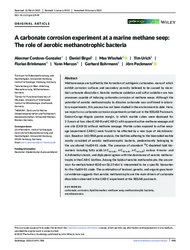A carbonate corrosion experiment at a marine methane seep: The role of aerobic methanotrophic bacteria
Cordova‐Gonzalez, Alexmar
Birgel, Daniel
Urich, Tim
Brinkmann, Florian
Marcon, Yann
DOI: https://doi.org/10.1111/gbi.12549
Persistent URL: http://resolver.sub.uni-goettingen.de/purl?gldocs-11858/10842
Persistent URL: http://resolver.sub.uni-goettingen.de/purl?gldocs-11858/10842
Cordova‐Gonzalez, Alexmar; Birgel, Daniel; Wisshak, Max; Urich, Tim; Brinkmann, Florian; Marcon, Yann; Bohrmann, Gerhard; Peckmann, Jörn, 2023: A carbonate corrosion experiment at a marine methane seep: The role of aerobic methanotrophic bacteria. In: Geobiology, Band 21, 4: 491 - 506, DOI: 10.1111/gbi.12549.
 |
Dokument öffnen: |
Methane seeps are typified by the formation of authigenic carbonates, many of which exhibit corrosion surfaces and secondary porosity believed to be caused by microbial carbonate dissolution. Aerobic methane oxidation and sulfur oxidation are two processes capable of inducing carbonate corrosion at methane seeps. Although the potential of aerobic methanotrophy to dissolve carbonate was confirmed in laboratory experiments, this process has not been studied in the environment to date. Here, we report on a carbonate corrosion experiment carried out in the REGAB Pockmark, Gabon‐Congo‐Angola passive margin, in which marble cubes were deployed for 2.5 years at two sites (CAB‐B and CAB‐C) with apparent active methane seepage and one site (CAB‐D) without methane seepage. Marble cubes exposed to active seepage (experiment CAB‐C) were found to be affected by a new type of microbioerosion. Based on 16S r RNA gene analysis, the biofilms adhering to the bioeroded marble mostly consisted of aerobic methanotrophic bacteria, predominantly belonging to the uncultured Hyd24‐01 clade. The presence of abundant 13C‐depleted lipid biomarkers including fatty acids (n ‐C16:1ω8c, n ‐C18:1ω8c, n ‐C16:1ω5t), various 4‐mono‐ and 4,4‐dimethyl sterols, and diplopterol agrees with the dominance of aerobic methanotrophs in the CAB‐C biofilms. Among the lipids of aerobic methanotrophs, the uncommon 4α‐methylcholest‐8(14)‐en‐3β,25‐diol is interpreted to be a specific biomarker for the Hyd24‐01 clade. The combination of textural, genetic, and organic geochemical evidence suggests that aerobic methanotrophs are the main drivers of carbonate dissolution observed in the CAB‐C experiment at the REGAB pockmark.
Statistik:
ZugriffsstatistikSammlung:
Schlagworte:
carbonatecorrosion
lipid biomarker
methane seep
methanotrophic bacteria
microbioerosion
This is an open access article under the terms of the Creative Commons Attribution License, which permits use, distribution and reproduction in any medium, provided the original work is properly cited.

